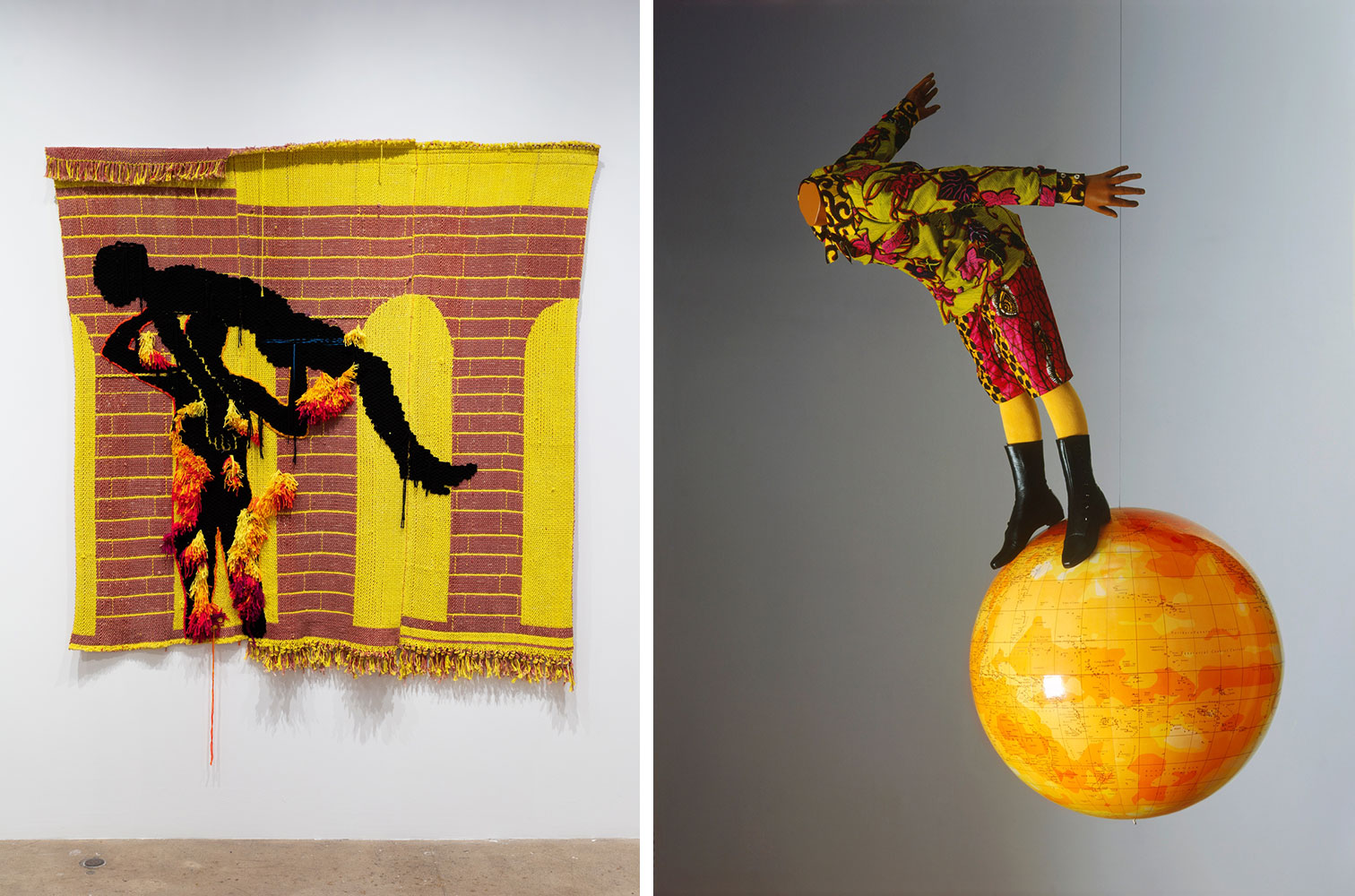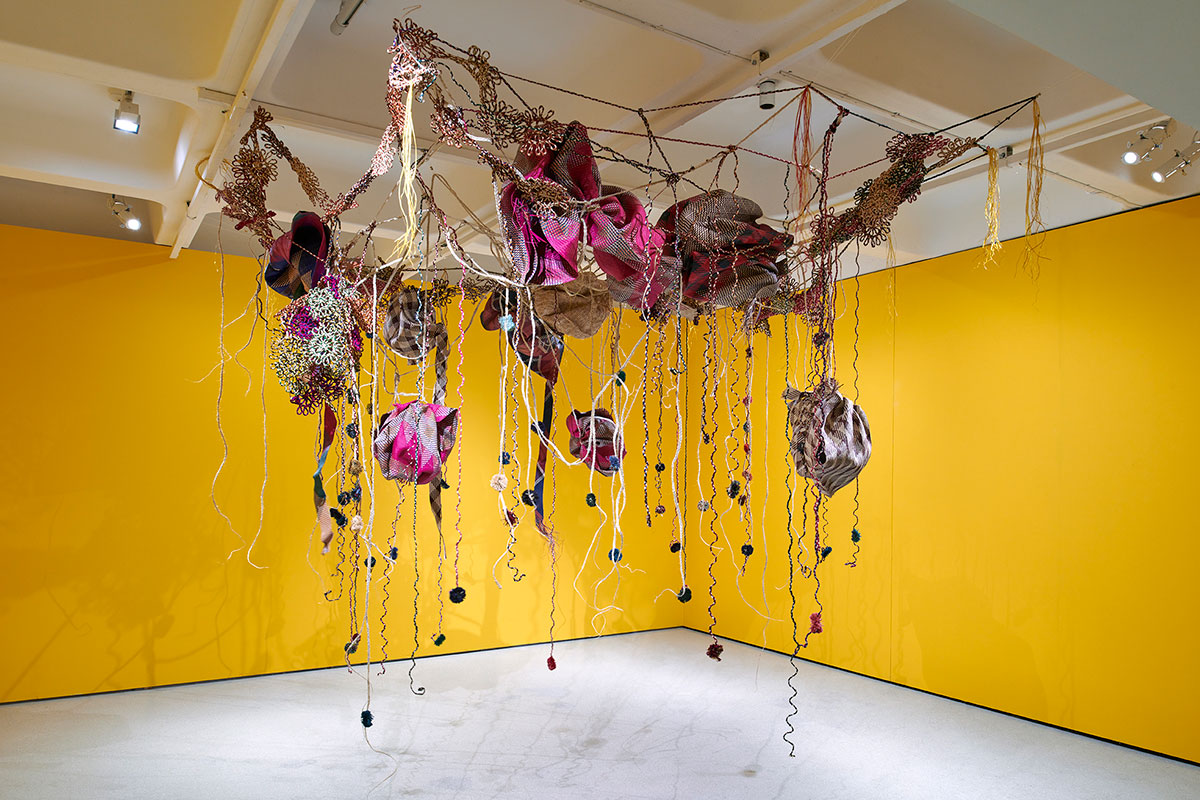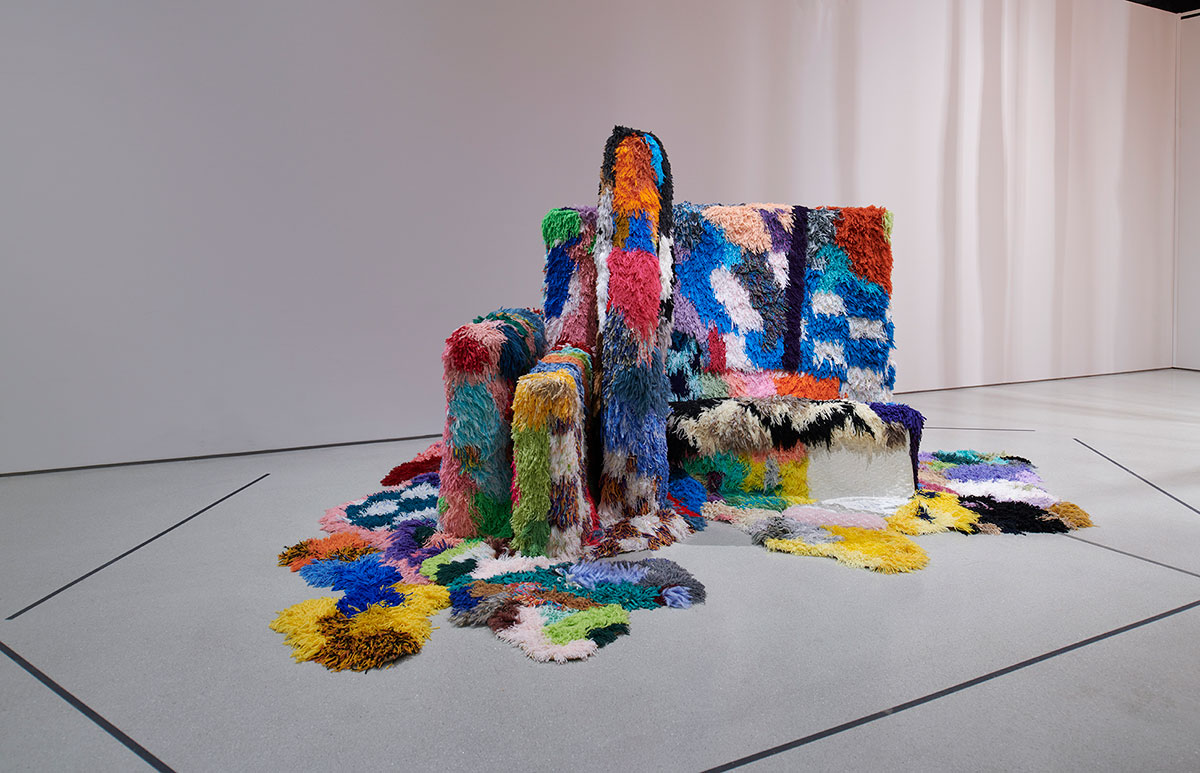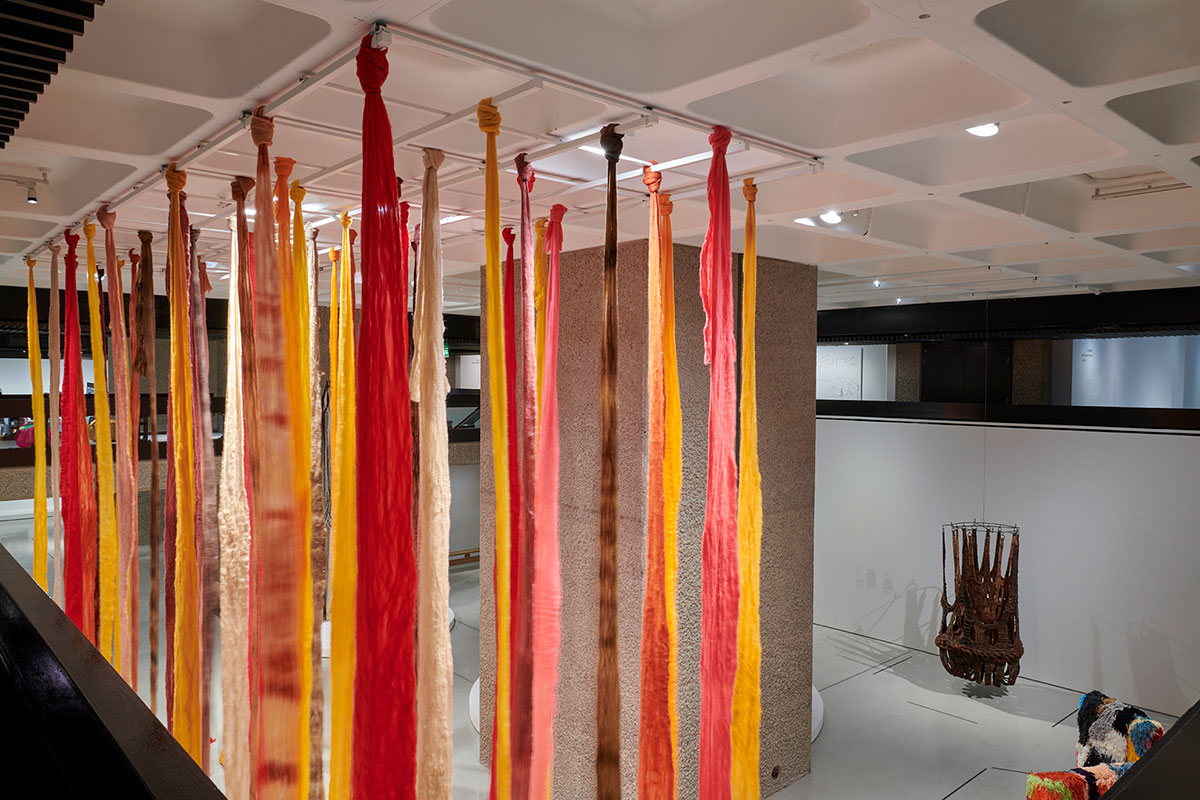PRESENTATION: Unravel-The Power and Politics of Textiles in Art
 Textiles weave through our everyday lives yet remain one of the most underexamined mediums in art history and contemporary practice. The universality of fabric has made it a potent messenger across global contexts – whether communicating personal stories or conveying hidden messages. Embedded in a single thread is the material history of the medium, revealing ideas relating to gender, labour, value, ecology, ancestral knowledge, and histories of oppression, extraction and trade (Part I).
Textiles weave through our everyday lives yet remain one of the most underexamined mediums in art history and contemporary practice. The universality of fabric has made it a potent messenger across global contexts – whether communicating personal stories or conveying hidden messages. Embedded in a single thread is the material history of the medium, revealing ideas relating to gender, labour, value, ecology, ancestral knowledge, and histories of oppression, extraction and trade (Part I).
By Efi Michalarou
Photo: Barbican Art Gallery Archive
The exhibition “Unravel: The Power and Politics of Textiles in Art” shines a light on artists from the 1960s to today who have explored the transformative and subversive potential of textiles, harnessing the medium to ask charged questions about power: who holds it, and how can it be challenged and reclaimed? Spanning intimate hand-crafted pieces to large-scale sculptural installations, this major exhibition brings together over 100 artworks by 50 international practitioners. Drawn to the tactile processes of stitching, weaving, braiding, beading and knotting, these artists have embraced fibre and thread to tell stories that challenge power structures, transgress boundaries and reimagine the world around them. Organised thematically, with artists placed in intergenerational and transcultural dialogues, the exhibition considers the various ways in which artists have used textiles to speak to stories of marginalisation and exclusion, as well as emancipatory joy and transcendence. The show’s earliest works were created in the 1960s, when many artists were pushing the sculptural boundaries of the medium and challenging the limiting parameters of ‘fine art’ and ‘craft’. Expanding across both time and geography, the exhibition presents six themes: “Subversive Stitch”, “Fabric of Everyday Life”, “Borderlands”, “Bearing Witness”, “Wound and Repair” and “Ancestral Threads”: which together explore the role of textiles in artistic practices that challenge dominant narratives push up against regimes of power, and manifest an enduring spirit of hope. The exhibition weaves together an international, intergenerational array of artists and artworks, bound by their engagement with the practice of textiles – at once intimate and capacious in its reach across cultures, geographies, and ages. Guided by artworks that are radical in their form and their politics, the exhibition sets out to ask why textiles are a particularly resonant medium to address ideas of gender and sexuality, the movement and displacement of people, and histories of extraction and violence, as well as understanding the world through connecting with ancestral practices and communing with nature. The exhibited artworks encompass a wide range of forms, scales and techniques, drawing on historic forms of making as well as new and experimental processes. The exhibited artworks encompass a wide range of forms, scales and techniques, drawing on historic forms of making as well as new and experimental processes. Among the artworks are embroidered blankets by Feliciano Centurión who – harnessing the association of textile as a gendered, feminine craft – embroidered poetic reflections onto found fabrics to process his HIV diagnosis in 1993. An intimate installation of 64 items of clothing wrapped in unspooled yarn by Sheila Hicks, a leader of the fibre art movement in the 1960s whose work challenged the prevailing hierarchy between art and craft at the time. T. Vinoja’s delicately handstitched aerial landscapes inspired by testimonies from the Sri Lankan Civil War (1983-2009) that use the language of maps and borders to explore ideas such as loss, mourning and forced displacement. Two tapestries and films by Teresa Margolles whose collaboratively-made, handstitched works commemorate the lives of individuals (Eric Garner in Staten Island and Jadeth Rosano López in Panama City) who were brutally killed. Each work was placed in contact with the body of the deceased, harnessing the ability of textiles to carry memory. Harmony Hammond’s large-scale work “Bandaged Grid #9” in which cloths and rags are applied to the surface of reclaimed canvas to suggest bandages over seeping wounds, reflecting on the way artists have used textiles to express healing and reparation. Yinka Shonibare’s figurative sculpture “Boy On A Globe” which, using his signature Dutch Wax fabrics, addresses race, class and the legacy of imperialism by reflecting on colonial trade and the entangled economic histories embedded within fabrics. Larger-than-life, deity-like macramé sculptures by Mrinalini Mukherjee, which surge up from the ground as though organic beings. Drawing on nature and myriad artistic references, their knotted, rippling forms confound expectations of textiles as two-dimensional. Cecilia Vicuña’s spatial installation “Quipu Austral” which, drawing on the history of textiles as ancient systems of communication, links the oppression of pre-colonial cultures to the devastation of the earth’s natural resources.
Participating Artists: Pacita Abad, Magdalena Abakanowicz, Igshaan Adams, Ghada Amer, Arpilleristas, Mercedes Azpilicueta, Yto Barrada, Kevin Beasley, Sanford Biggers, Louise Bourgeois, Diedrick Brackens, Jagoda Buić, Margarita Cabrera, Feliciano Centurión, Judy Chicago, Myrlande Constant, Cian Dayrit, Tracey Emin, Jeffrey Gibson, Antonio Jose Guzman and Iva Jankovic, Harmony Hammonds, Sheila Hicks, Nicholas Hlobo, Yee I-Lann, Kimsooja, Acaye Kerunen, José Leonilson, Tau Lewis, Ibrahim Mahama, Teresa Margolles, Georgina Maxim, Małgorzata Mirga-Tas, Mrinalini Mukherjee, Violeta Parra, Solange Pessoa, Loretta Pettway (Gee’s Bend), Antonio Pichillá Quiacaín, Faith Ringgold, LJ Roberts, Zamthingla Ruivah, Hannah Ryggen, Tschabalala Self, Yinka Shonibare CBE RA, Mounira Al Solh, Angela Su, Lenore Tawney, T. Vinoja, Cecilia Vicuña, Billie Zangewa and Sarah Zapata
Photo: Igshaan Adams, Gebedswolke (Prayer Clouds), 2021 – 2023, © Igshaan Adams, courtesy the artist and blank projects, Cape Town
Info: Barbican Art Gallery, Silk Street, London, United Kingdom, Duration: 13/2-26/5/2024, Days & Hours: Thu-Fri 10:00-20:00, Tue-Wed & Sat-Sun 10:00-18:00, www.barbican.org.uk/



Right: Jeffrey Gibson, SPEAK TO ME SO THAT I CAN UNDERSTAND, 2018, © Jeffrey Gibson, courtesy Sunderland- Cohen Collection

Right: Yinka Shonibare CBE RA, Boy on a Globe, 2008, © Yinka Shonibare CBE RA. All Rights Reserved, DACS 2023, courtesy the artist and Stephen Friedman Gallery, London

Right: Faith Ringgold, Tar Beach 2, 1990-92, © Faith Ringgold / ARS, NY and DACS, London, courtesy ACA Galleries, New York 2023 and Pippy Houldsworth Gallery, London Photo: Benjamin Westoby
![Left: T. Vinoja, Bunker & border, 2021, Courtesy the artist and ExperimenterRight: Feliciano Centurión, Eye with ñanduti c.1994, from La Mirada [the Gazing Eye series], Courtesy Cecilia Brunson Projects and Familia Feliciano Centurión](http://www.dreamideamachine.com/web/wp-content/uploads/2024/03/7A.jpg)
Right: Feliciano Centurión, Eye with ñanduti c.1994, from La Mirada [the Gazing Eye series], Courtesy Cecilia Brunson Projects and Familia Feliciano Centurión



